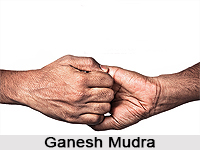 Ganesha Mudra is a type of mudra which aims to remove obstacles for us so that we can feel clearer and more joyful. A mudra is a hand gesture used to seal an intention into a yoga or meditation practice. Ganesha, the elephant god, is one of the most popular deities of Hindu mythology. He is supposed to help remove all obstacles from the path. The Ganesh Mudra is named after him because performing this Mudra is said to help lift the spirits and give the will to persevere when an individual is feeling down.
Ganesha Mudra is a type of mudra which aims to remove obstacles for us so that we can feel clearer and more joyful. A mudra is a hand gesture used to seal an intention into a yoga or meditation practice. Ganesha, the elephant god, is one of the most popular deities of Hindu mythology. He is supposed to help remove all obstacles from the path. The Ganesh Mudra is named after him because performing this Mudra is said to help lift the spirits and give the will to persevere when an individual is feeling down.
In Ganesh Mudra the left hand should be held in front of the chest with the palm facing outward. This Mudra should be done once a day and it helps to strengthen the heart muscles and open the bronchial tubes and release tension. It also opens the fourth chakra and boosts confidence in the practitioner.
Steps to Practice Ganesh Mudra:
•Sit down comfortably on a chair or on a yoga mat in the Padmasana.
•Bring both hands in front of the chest with elbows bent.
•Position the left hand with the palm facing outwards in such a way that the thumb points towards his/her solar plexus and the little finger points towards his/her collar bone.
•Form a claw by bending the 4 fingers of the left hand and clasp them with the 4 fingers of the right hand. In this position, the right palm should be facing towards the chest.
•Inhale deeply. On the exhale, try to pull both arms apart while keeping all 8 fingers locked. Feel the stretch along the shoulders and chest.
•Inhale once more and relax the arms while maintaining the Ganesh Mudra lock.
•Repeat this process 6 times.
•Interchange the hands, with right palm facing outwards and the left palm facing inwards and repeat this process.
•Release all tension from the arms and bring them close to the chest so that the hands are touching the sternum.
Benefits of Ganesh Mudra
The benefits of the Ganesha Mudra extend to the cardiac muscles, the muscles of the chest, shoulders, and arms. It also helps to release any pent up tension from the shoulders and chest.




















